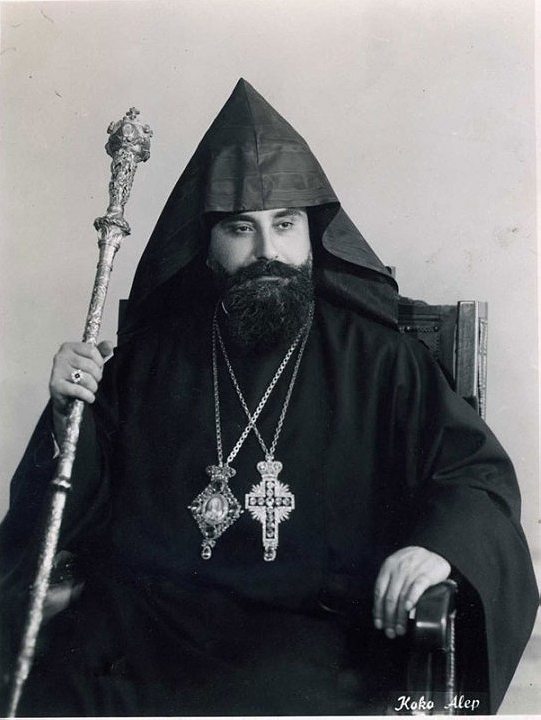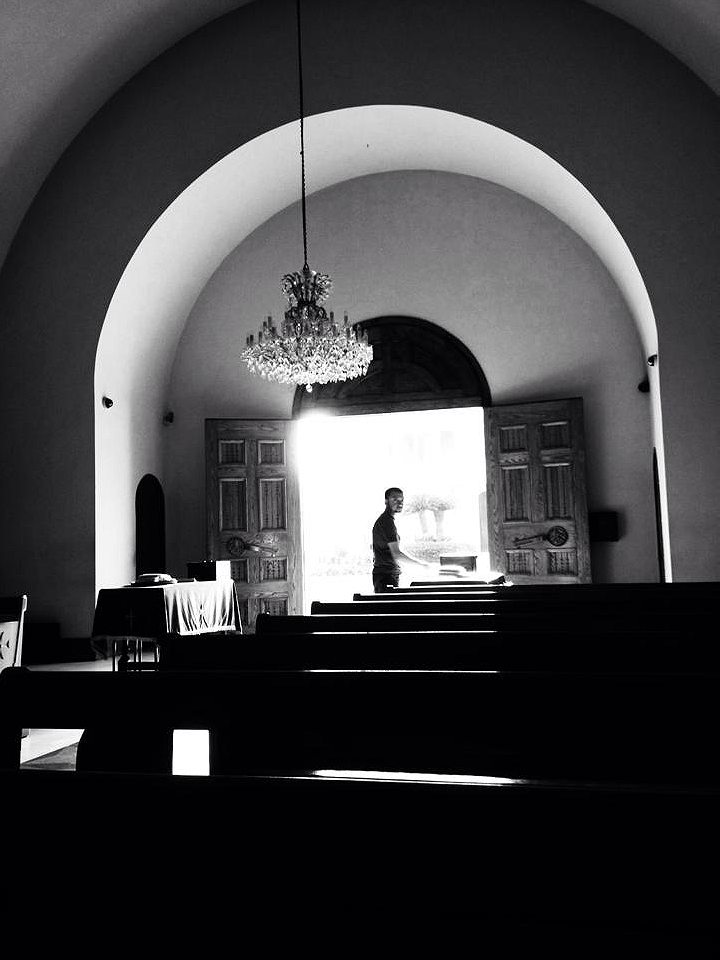Boston-born songwriter and poet Arto Vaun travels to Beirut to find a deeper truth about a relative he never met.
The large black-and-white photo of him in our living room never frightened me. His long dark beard; the pointy black hat; his thick fingers gripping an ornate staff; heavy crosses on chains draped over his black vestments; and his tired, kind eyes. I would sometimes notice the photo as though for the first time and just gaze at it, at him, locking eyes for a moment. This stranger who had died before I was born, who was sacrificed at a young age in one of the most pivotal, tumultuous periods in the history of Armenia, the Cold War, and the Middle East. This melancholy, radiant, overweight man looking at me year after year. Then one day as I was watching him watch me, I realized: without the beard, the vestments, and weight, he looked just like his youngest brother, my father, a working-class mechanic in Boston.
My uncle was Catholicos Zareh I of the House of Cilicia. And if that doesn’t mean anything to you, don’t worry: it took me a long time to understand the man and his legacy. I’m still working on it, in fact. I knew him from stories: he was born during the Armenian Genocide of 1915, that he was truly spiritual even from a young age, that he died young as well: a victim of heart attack, brought on, many say, by the stress of a great division among his people. I knew that the nearly half a million shocked people who poured into the streets of Beirut in February 1963 for his funeral were not all his supporters—Armenians were at war with themselves in those days. But recently I’ve been visiting Beirut, and I’m finding that the Armenians there know him still, and they’ve been teaching me what the man truly meant.

The August humidity is intense as I head to Antelias, the Holy See of the Cilician Armenian Church, which dates back to the 4th century AD. After the genocide, the catholicosate (one of two seats of the Armenian church) was forced to move from its historic home in Sis, in present day Turkey. First it moved to Aleppo in 1921 and then settled in Beirut in 1924. The church has always played an integral role as a refuge and center of identity after pogroms throughout the ages, and it was no different after the genocide, when it provided the only semblance of unity, hope, and perseverance in the face of mass devastation, migration, poverty, and loss.
I’ve decided to just show up in Antelias without letting anyone there know about my connection to Zareh. An older man with white hair and a moustache lets me into the church compound, greeting me warmly, then disappearing back into his office. No one else seems to be around. I walk into the quiet, wide courtyard that’s pale and glowing in the searing sunlight. I can hear the musical chaos of Beirut traffic on the other side of the high walls as I approach where my uncle is buried, next to the main cathedral. The first thing I see is one violet carnation placed casually on his tomb. All I can bring myself to do is lightly place my hand on the warm marble and touch his name.
Stalin had deceived many thousands of Armenians into “repatriating” to Soviet Armenia
The controversy around Zareh’s election as Catholicos in 1956 was due to his outspoken stance against the USSR’s version of communism, and its mistreatment of Soviet citizens, specifically Soviet Armenians. Only ten years earlier, Stalin had deceived many thousands of Armenians into “repatriating” to Soviet Armenia. The bulk of those who fell for the ideological bait were from Syria and Lebanon. They gave up relatively stable lives for an idea that was, in the end, nothing close to the reality. When they reached Soviet Armenia, their assets were seized and they were forced to live in mostly abject conditions. Many were sent straight to Siberia. Yet opinion about the place was surprisingly divided among Armenians—some saw it as the first Armenian homeland in decades, while others wanted to rescue their brethren from Stalin. It was very much a visceral issue, polarizing Armenians all over the world, but especially in the Middle East, where the large portion of genocide survivors had ended up after WWI, and where the Cold War was now being played out in different ways. Although all Armenians knew of the awful conditions in the Soviet Union, they were bitterly split on whether to support Soviet Armenians and work in more diplomatic ways to assist them, or to more directly organize and struggle to undermine Soviet Armenia and communism in order to “liberate” Armenia. Both sides grew increasingly entrenched and extreme in their approaches.

That polarization in Beirut during Zareh’s election lead to violence and chaos. At no other time in modern Armenian history have Armenians clashed with each other the way they did during those few years. Pro-Soviet Armenia factions sent prostitutes to taunt him; there were protests by pro-Soviet parties; ancient relics were stolen from Antelias; and cartoons depicted him as, among other things, a donkey. It got to the point where the Lebanese president at the time, Camille Chamoun, ordered the army to patrol and secure the Armenian neighborhoods in Beirut. When Zareh’s mother (my grandmother) died suddenly in 1958, Zareh was not able to attend her funeral in Aleppo because of fear that his opponents might keep him from returning. Five years later, he would follow her, at age 48, due to sudden cardiac arrest. One can see in his photos between 1950 to 1963 a transformation that speaks volumes about his position and the times—a robust, jet black-haired young man turning into an exhausted, gray-haired old man, whose eyes still flicker, but whose face gives away a profound frustration, sadness, and pain.

During my first trip to Beirut in 2002, I was bowled over by the energetic and passionate reaction I got from people who were told that Zareh was my uncle. Just the fact that my Lebanese-Armenian friends felt it necessary to point out my relationship to him whenever we met new people was peculiar. It’s not something I bring up or talk about much. But now that I’ve been there a few times, I think there’s a collective guilt on all sides, and that’s part of the thoughtful reactions to him, 50 years after his death. Each person who talks about him to me, no matter their background, says something like, It was so sad what happened to that man. He was a saint, in the wrong place at the wrong time.
I usually smile slightly and say, That’s nice of you, thank you. What else can I say? I’m not one-tenth of the devout, selfless man that he was. I don’t deserve those kinds of gracious responses from people about someone I never even knew. But the more I’m drawn to Beirut, the more I understand that my tiny, transient role is to allow people to express those feelings, which are, amazingly, still so strong all these years later. And in a way, it helps me connect to the man in the photo who watched me grow up, and who I feel a deeper tie to with each year.

1983: I’m a little kid in our kitchen in Boston. My mom’s older cousin is sitting at the table with my parents, having coffee. He begins to softly and uncomfortably tell my dad that his father, my grandfather, has died in Aleppo, at age 98. My father crumples like paper. Soon after his brother Zareh died in 1963, my dad, who was in the Syrian army at the time, left Syria to avoid being called to fight in the growing conflict with Israel. He never saw his father again. As I watch him sob, all I can do is wrap my little arms around his neck and cry with him. Seven years later, I will suddenly lose him too, one Sunday evening in November. He’ll go the exact way his oldest brother did.
My family’s story is, like that of so many other Armenians, and non-Armenians, from the Middle East, riddled with loss, uphill battles, and unwanted sea changes. And this ties me forever to Beirut and Aleppo, drawing me like a warm light inside a home. They are two cities that are again struggling to breathe in a claustrophobic deluge of ideological and political shortsightedness, extremism, and outside meddling.
On the flight back to Armenia from Beirut a few weeks ago, I thought about that random carnation on my uncle’s tomb, then remembered suddenly: Carnations were my dad’s favorite flower – he used to buy them often for my mom for no particular reason.
During these trips to Beirut, it seems, I am not just visiting my uncle, but also being visited by him.